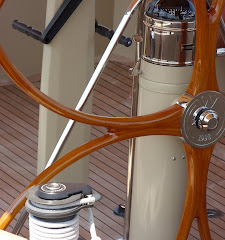After the paint had set for 24 hours we could finally resume building something and it couldn’t happen soon enough. With all the delays, economic setbacks and miscellaneous side projects it seemed as though this stage would never arrive.
Arrive it has and it has certainly lifted the spirits and we’re working with a renewed vigor. All the parts that weren’t cut and waiting were quickly laid out and cut. I laid out the aft seat/decks as outlined on the plans sheet and cut them out and immediately remembered I had planed to leave the outside arc a little proud and trim it back to fit with the router. Well to late for that I guess. There was some discrepancy all right and it will take a little filling to correct but nothing major and certainly not the worst thing on the whole project. I knew the angled transom was a little wide and I would need to pull the hull sides in to mate the parts up. We did this very easily with a ratchet strap. All the pieces were stitched together just like the hull long ago and the fit wasn’t half bad all around. We tacked everything in place with thickened epoxy and then began the fillets on the inside.

This was the least fun I have had working on the entire boat. I don’t know of any other way to do this though so all I could to was recruit some help and get it over with. Laying face up in the aft bunk areas my helper would mix a batch of thickened epoxy and pass it to me through the aft end where the angled transoms would later be. One stringer then a hull/deck joint then the frame joint, slowly it all got its neat little fillet and I crawled out.
Of note here is an addition to the plans we felt necessary. There are no stringers designed into the frames under the cockpit floor, forward deck or along the aft deck/seats. These areas all span over 12 inches by up to 20+ inches and we felt it was going to be the week link in the boat. These are high traffic spots also.
Of note here is an addition to the plans we felt necessary. There are no stringers designed into the frames under the cockpit floor, forward deck or along the aft deck/seats. These areas all span over 12 inches by up to 20+ inches and we felt it was going to be the week link in the boat. These are high traffic spots also.

We added the following stringers:
Cockpit deck - 2- 1 ½” x ¾”from the transom to frame “C” or the companion way frame evenly spaced.
Forward deck - 1- ¾” x ¾” about 8” in from and following the line of the gunwale from frame “E” to the spinnaker pole box forward of frame “A” each side.
Aft deck/seats an additional 1 ½” x ¾” by about 5 feet between frame “A” and “C”.
The pictures do not show the cockpit floor stringers.
That brings us up to date for the most part. We have been doing the filling and prep work to place the fiberglass on the deck and cockpit area but before that takes place we will need to tackle the cabin deck/roof. This has several possible approaches and we must decide on one quickly.
Time this segment:Cut and fit decks, seats and stringers 4 hours
Tack weld above parts in place 1 hour
Fillets inner stingers and joints 6 hoursLight sand, round over edges, prep decks, seats for fiberglass 1 hour Total this segment 12 hoursTotal Project: 145 hours
Cockpit deck - 2- 1 ½” x ¾”from the transom to frame “C” or the companion way frame evenly spaced.
Forward deck - 1- ¾” x ¾” about 8” in from and following the line of the gunwale from frame “E” to the spinnaker pole box forward of frame “A” each side.
Aft deck/seats an additional 1 ½” x ¾” by about 5 feet between frame “A” and “C”.
The pictures do not show the cockpit floor stringers.

That brings us up to date for the most part. We have been doing the filling and prep work to place the fiberglass on the deck and cockpit area but before that takes place we will need to tackle the cabin deck/roof. This has several possible approaches and we must decide on one quickly.
Time this segment:Cut and fit decks, seats and stringers 4 hours
Tack weld above parts in place 1 hour
Fillets inner stingers and joints 6 hoursLight sand, round over edges, prep decks, seats for fiberglass 1 hour Total this segment 12 hoursTotal Project: 145 hours







